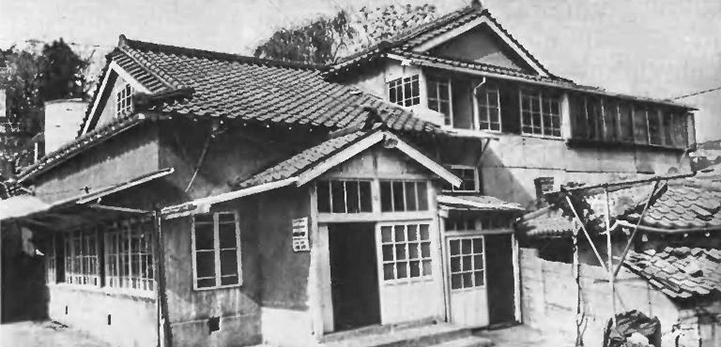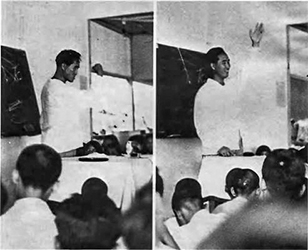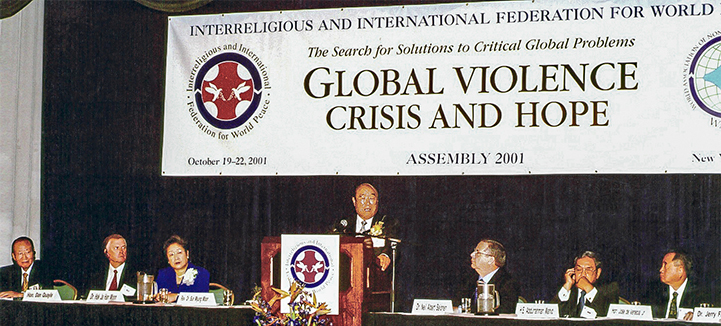All the Lands We Loved
This week in history: October 5-11
- The Cheongpa-dong Church is purchased
- The Belvedere estate is purchased
- CARP confronts communism in West Germany
- A post-9/11 conference on “Global Violence: Conflict and Hope” is held
October 7, 1955
Cheongpa-dong Church Purchased


True Father teaching at Chungpa Dong.
Three days after True Father’s release from Seodaemun Prison, the church borrowed 2 million won to purchase an abandoned building in poor repair on a hillside in Cheongpa-dong, Seoul. It reportedly had been a small Japanese Buddhist temple during the colonial era and one of many houses categorized as “enemy property.” This was the first property purchased by the Unification Church, which previously had occupied rented space, and was its headquarters building for the next 20 years. It was the site of True Parents’ engagement and Holy Wedding as well as the 36 and 72 Couples Holy Weddings. It was where the earliest editions of the Divine Principle were distributed. It served as True Parents’ residence and was where True Father planned the church’s world mission.
Later, while in the United States, True Father received word that members were planning to remodel the Cheongpa-dong Church. With great urgency he sent a telegram telling them to stop. True Father wrote in his autobiography, “This church embodies an irrecoverable period in my personal history, but more important than that, it testifies directly to the history of our church. … What matters is not some beautiful exterior but the secret life of tears that dwells within that building. … When I look at a particular pillar, I am reminded of a time when I clung to that pillar and wept over a particular matter … [it] makes me weep again. To see a door frame that is a little crooked reminds me of the past. … The floor boards where I bent over in prayer and shed so many tears are gone. … I … need memories of that pain. It doesn’t matter if the external style or appearance is old. Much time has passed, and now we have many churches that are well built. But for me, I would rather go to the small house on the hill in Cheongpa-dong and pray. I feel more comfortable there.”
October 10, 1972
Belvedere Estate Purchased
In 1972, True Father directed Unificationists in the United States to find a large property in New York suitable for use as an international training center. The assignment was given to New York center director Philip Burley, who found Belvedere three days after it had been put on the market. Situated on the Hudson River thirty miles north of New York City in Tarrytown, the twenty-two-acre estate was described in a brochure sent to True Father in Korea, and he said to buy it.
The Maryland church center had had success selling its own manufactured candles, and it was decided to try that as a national effort to raise money for the large down payment. For seven weeks nearly every member in every state abandoned all other activities in order to sell candles.
With Anchor Hocking six-ounce brandy snifters and Amoco paraffin piled floor to ceiling, the College Park/Upper Marlboro centers reached peak production of 1,700 dozen candles a week, or about 250 dozen (3,000 candles) a day. A similar factory with a rotating crew was set up in the Denver center garage, and a third factory was operated by the Berkeley, California, center. “Express candle vans” delivered “still warm” candles, and “mobile fundraising teams” were formed for the first time. As a result of the total mobilization and fundraising innovations, the down payment was made. At 1:00 p.m. on October 10, 1972, the caretaker of Belvedere received a call from the seller saying that, from that moment, “Belvedere is in new hands.” Later that day a group of Unificationists arrived to explore the house and grounds. Dr. Young Oon Kim asked them, “How can you describe a miracle? … Now you have seen Belvedere. Is it better than your dreams?”
October 10, 1981
CARP Confronts Massive Leftist Demonstration in West Germany
The Collegiate Association for the Research of Principles (CARP) spearheaded the Unificationist opposition to communism on college campuses from the 1960s. In the early 1980, US CARP launched an organized assault on Marxist-Leninist doctrines under the leadership of Rev. Chong Goo “Tiger” Park. Prior to this, a Revolutionary Communist Youth Brigade (RCYB) had assaulted CARP members on a California campus. This was the first of innumerable confrontations between CARP and leftist campus groups over the next several years. Many of the most memorable encounters occurred in traditionally liberal or radical campus settings, such as the University of California at Berkeley and the University of Wisconsin at Madison.
In what was one of CARP’s most memorable confrontations, “Tiger” Park led a counterdemonstration of 130 CARP members against a 250,000-strong anti-nuclear armament rally in Bonn, Germany, on October 10, 1981, barely escaping after being pursued by attackers wielding sticks, pipes and chains. This was the kickoff to a decade of activism. CARP developed a revolutionary, activist élan of its own replete with practiced chants, burnings of Soviet leaders in effigy, hard-driving rock bands with names such as Blue Tuna and Prime Force, and touring martial arts groups (these were especially helpful in protecting podiums from assaults). All this became part of the lore and allure of CARP during the Cold War era.
October 10, 2001
Post-9/11 Conference on “Global Violence: Conflict and Hope”

Like the rest of the world, the Unification Church and its affiliated organizations were shocked by the tragic events of September 11, 2001. After a 12,000-Couple World Clergy Blessing scheduled for September 22 at Madison Square Garden was canceled, a “Day of Prayer and Healing” prayer breakfast and rally were held in the heart of Manhattan. However, True Father did not consider this to be sufficient and convened a major gathering at the New York Hilton from October 10 to 13 to address “root causes and potential solutions to global violence.” Assembly 2001 was the second in a series of meetings sponsored by the Interreligious and International Federation for World Peace (IIFWP) to address global problems. The event convened some 400 political and religious leaders, media representatives, NGO representatives, scholars and peace activists from 101 nations, whom conference organizer Dr. Thomas Walsh congratulated for their “courage” in coming to New York.
Those attending included former U.S. Vice President Dan Quayle; H.E. Abdurrahman Wahid, former president of Indonesia and head of the world’s largest organization of Muslims; the former presidents of Guatemala, Seychelles, Costa Rica, Belarus and Mongolia, and the former governor-general of Canada as well as many religious leaders such as Dr. Jerry Falwell, founder of Liberty University, Minister Louis Farrakhan, leader of the Nation of Islam, and Rabbi David Broadman, chief rabbi of two cities in Israel.
In his closing banquet address, “Let Us Discover the True Meaning of I,” True Father focused on human beings finding their “true” selves. This, he said, was possible only through “living for one’s family, nation, world and God.” In this way, “I” expands to ever more inclusive levels of “we.” Based on this vision of solidarity, True Father asked participants to go out to the world as “God-appointed ambassadors to realize world peace.”
This Week in History briefly lists significant events in the history of the Unification Church, the lives of the Founders, and world events that are momentous to Unificationists. Most items are marked according to the solar calendar. Items marked “H.C.” correspond to the Cheon-gi or Heavenly Calendar, which is based on the lunar calendar. This installment covers the week of October 5-11.

